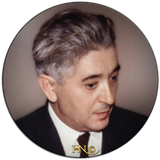Encircled - The influence of Japanese Mon and Chinese Xi
The artist's style continued to evolve from its early European influence to Asian influence. Hnizdovsky was greatly influenced by Japanese mon (family crests) where botanical or animal elements are highly stylized, often turned into a repeating patterns, and oftentimes encircled. Slowly, this Asian tradition of encircling, which he had used in his ex libris designs numerous times, made its way into his larger prints.
At the same time, Hnizdovsky was researching his own family's coat of arms at the New York Public Library, and yet, European blazons did not have the hold on him that Asian family crests had. He felt that the European tradition of heraldry was overly pompous, whereas the Asian tradition, highly decorative and more often based on stylized botanical or animal elements, the subjects most dear to the artist. Japanese mon are monochrome, much like most of Hnizdovsky’s prints.
Hnizdovsky was also exposed to Chinese xi through fellow woodcut artists from China and Taiwan. He even incorporated one into a fellow artist’s ex libris. The Hnizdovskys also have a collection of Chinese xi rendering their name into stylized Chinese characters.
It has been written that Hnizdovsky encircled his works as compensation for trauma and melancholy, whereas nothing could be further from the truth. The artist maintained a childlike innocence of wonder and joy his entire life. He spent his life doing what he cherished the most - art.
He saw the true essence of his animal and botanical subjects by capturing and successfully rendering the magnificent patterns created by nature, never replicating, just capturing the reality of nature's own glorious patterns. For his peacock print, he counted how many feather eyes there were before working on his sketch. Nothing was made up, no details were added that weren't originally there. Hnizdovsky was simply obsessed with patterns, as can be seen in his rendering of the Jefferson Wall, seen above. Stylized yes, invented, no.
Hnizdovsky was also obsessed with Japanese textiles, Japanese decorative swords, Chinese cloisonné, Chinese snuff bottles and Chinese ivory. The element they all shared is repeating, highly decorative patterns.
Hnizdovsky captured patterns that are everywhere in nature, stylizing them, but never making up reality. For books he illustrated, he interpreted what he visualized from the text, not adding, not subtracting, not compensating, never politicizing. You can see several examples in the prints shown below.











